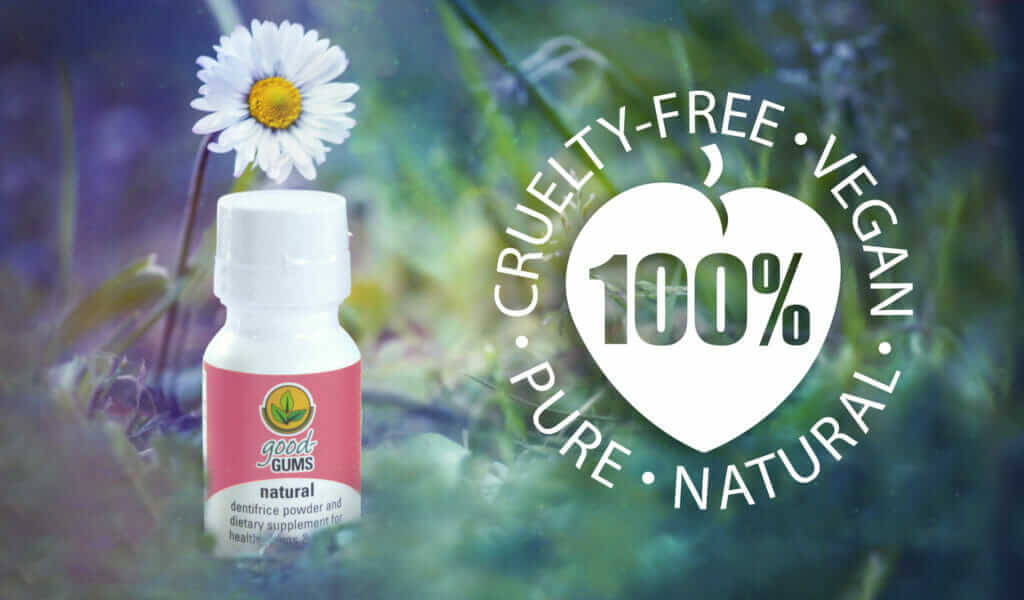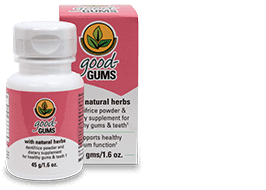Have you been using a toothpaste which has a warning on the back of the package to call poison control if swallowed? Are you worried about what these chemicals are doing to your body? Do you even wonder what chemicals you may be absorbing each time you bush your teeth and feel misled by conventional toothpaste manufacturers?
It’s something we all wonder about when using mainstream products. We get it. Sometimes it’s just easier (and cheaper) to buy conventional products from the grocery store, but we have to ask ourselves, “Is it really worth it?” when what we are putting into our bodies is potentially causing us harm.
Don’t worry! Good-Gums is here to help!
The scientifically backed ingredients in Good-Gums are specifically designed with ingredients found in nature to support your body’s healing itself naturally. When using Good-Gums, you can rest assured that what you’re putting into your body is completely natural, with no artificial chemicals, colorants or flavorings and that it is safe to ingest. You can feel good about eliminating at least one source of unnecessary toxins and that what you’re putting into your mouth is helpful to your living tissue.
Carole SI love it because I love anything that is all natural and loaded with top ingredients. When I saw that Good Gums used – as one of many excellent ingredients – French grey sea salt, that was all I needed in order to know that the people who run this company use the finest, purest ingredients. I use French grey sea salt for many things because it is THE healthiest!!*

What does it mean to use a product with artificial toxins and chemicals?
The gums are some of the most absorptive tissues in the body, and readily absorb almost any toxin or chemical irritant with which they come into contact. (Baseball players chew tobacco precisely because of how rapidly and efficiently their gums absorb the nicotine.) Yet many products intended for oral care (such as toothpastes, mouthwashes, and oral health remedies) routinely contains a sizeable list of artificial chemicals: surfactants, preservatives, endocrine disrupters, and artificial colors and flavorings. For many people, it’s merely an additional chemical burden that the body must filter out and dispose of, but for some people who are dealing with chronic illness, that additional chemical burden can have more serious effects.
In Europe, over 1,500 ingredients are identified and prohibited from inclusion in personal care products; in the USA, only 11 synthetic chemical ingredients have been prohibited. Many toothpaste manufacturers who sell internationally sell (at a profit) a different formula overseas in order to comply with the restrictions of their laws, but in the US they sell a formula that’s slightly cheaper to produce with ingredients that aren’t prohibited in the US. So it’s up to buyers in the US to be aware of what’s in the products they put in their mouth and to decide what to avoid.
Sodium fluoride or stannous fluoride or sodium monofluorophosphate are forms of fluoride found in toothpaste. Fluoride is so toxic that any toothpaste containing it is required to post a warning “to get medical help or contact a Poison Control Center right away” if a person swallows more than is used for brushing. A lethal dose is 5 to 10 grams for an adult and half of a gram for a child. A less than lethal dose can still cause severe health problems. One dose of a full stripe of toothpaste across the length of toothbrush bristles contains approximately 2 mg of fluoride. So a child that swallows a full, large tube of toothpaste could be ingesting a lethal dose.
Toothpaste often contains surfactants, such as sodium lauryl sulfate, which is a chemical compound strong enough to be used as an engine degreaser. Triclosan is an artificial chemical developed in the 1960’s that is being investigated for its role in disrupting hormonal development and for its role in the emergence of antimicrobial resistance (“superbugs” that are resistant to antibiotics).
Diethanolamine (DEA) is harmful if swallowed, inhaled or absorbed through the skin and is classified as “possibly carcinogenic to humans.” It helps to enhance the creamy texture of toothpaste.
Various types of abrasives are added to toothpaste, often comprising 50% or more of the paste. The abrasives are intended to grind away sticky plaque that adheres tightly to the teeth at the gum line, but the abrasives also grind away at dentin and enamel and cause enamel erosion. Abrasives are used in virtually all toothpastes, and in virtually all of them the abrasiveness is more than enough to damage teeth. The structure of a tooth is mostly dentin with harder enamel covering the exposed upper part. Sometimes dentin is exposed when gums recede, and the abrasiveness of toothpastes is enough to damage dentin; virtually all toothpastes still have enough abrasiveness to erode enamel.
Colorants and flavorings also introduce artificial chemicals into oral products, and there are few if any restrictions on what can be used. Glycerin is a cheap hygroscopic substance that’s derived from fats or oils, and into which many things can easily dissolve (even more easily than in water). It gives toothpaste its creamy paste consistency, but it also coats the teeth and gums with a film that’s been shown to prevent the natural process of saliva-remineralization by which enamel is restored.
If you read the list of ingredients of your oral care products, you’re likely to find it is a chemical soup of artificial and exotic chemicals that shouldn’t come into contact with sensitive and absorptive oral tissues. Even “natural” toothpastes have some of the questionable or harmful ingredients. But that’s not necessary when natural ingredients can provide all the plaque-cleaning and gum-supporting capability you need.
Let’s see how Good-Gums can help!
astara sI want to thank you for creating Good Gums. A friend told me about your product when I needed most to bring in a natural solution to my dental health. I was given a rather unsettling report and sent to a periodontal dentist. I used the powder for 2 months before seeing him and the pockets were so reduced there was no talk of scraping or tooth loss. I am thrilled with the results and plan to continue to use good gums ! I have recommended this product to my brother and a friend since getting my clean bill of health form the periodontist!
thank you so much.*
How our combination of SCIENTIFICALLY BACKED ingredients help:
Good-Gums is specifically formulated for gums with clinically proven ingredients of the highest purity and potency. It works with your body’s natural processes, whose predisposition is to heal and nurture. Good-Gums takes advantage of two facts about your gums: their cells have some of the fastest replacement rates in your body, and they are comprised almost entirely of connective tissue. In most of the body a cell lives for an average of 7 to 10 years before being replaced, while a new gum cell is replaced after only 7 to 14 days. Healthier gum cells can start replacing less-healthy cells quickly, if they are given what they need. What new gum cells need is what all connective tissue cells absolutely rely on for their formation: a large amount of vitamin C. Good-Gums is unique in providing a healthy amount of vitamin C, plus citrus bioflavonoids that help the body utilize the vitamin C. Check the labels: other products (whether pastes. balms or essential oils) just don’t provide it. The Good-Gums formula dissolves right in the mouth to be absorbed directly by the gums, where it’s needed the most.
The Good-Gums formula also contains a lot of alkaline baking soda to buffer the acidity of its vitamin C, thereby protecting your enamel from acid erosion. To keep the alkaline baking soda from reacting with the acidic vitamin C in the bottle, the entire formula is kept in a dry powder state. When the powder meets saliva in your mouth, it becomes a liquid solution that starts getting absorbed by the gums immediately before these two ingredients (alkaline and acidic) could react or could weaken the vitamin C.

Good-Gums is absorbed more easily by the inclusion of French grey sea salt in our formula, which has a mineral balance similar to human-produced fluids (so much so, that it was successfully used in place of blood for transfusions to some wounded sailors in WW-II, when blood wasn’t available). This matching mineral composition avoids an ion imbalance that would otherwise stop absorption through cell membranes. Since more of the Good-Gums solution can be absorbed, it can do its work quicker and better.
Besides supporting the growth of healthier new gum cells, Good-Gums also has herbal ingredients that soothe sore gums. Myrrh and peppermint are famous for their soothing properties. Cinnamon is a potent anti-inflammatory. And salt solutions are so soothing as to be the standard recommendation by dentists after oral surgery. All are carefully-selected ingredients of Good-Gums.
To help control the population of the plaque-producing bacteria, peppermint, myrrh, and cinnamon act as natural antimicrobials. Baking soda, besides buffering the acidity of vitamin C, also makes the oral environment less favorable for the proliferation of acid-loving, plaque-producing bacteria.
To help remove plaque from constant contact with the gum margins (where they can re-infect the gums), Good-Gums employs the extraordinary property of cranberry, which significantly loosens the grip of plaque bacteria on the nanoscale, so that it the plaque bacteria can more easily be removed by the mechanical action of toothbrush bristles and floss.
Your gums can improve by the combination of these three strategies: by our unique active nutritional support for the formation of healthier new gum cells, by soothing sore tissue while your gums are recuperating, and by reducing the excessive numbers of and contact by infectious agents.
try it and see for yourself…

Healthy teeth and gums – for life!
Good-Gums goes to work straight away. Feel the difference as our unique formula – containing everything teeth and gums need to heal and restore – takes effect.
During the first one or two bottles, you are likely to notice a definite improvement to your gums. They may feel firmer and tighter. If your gums had previously been bleeding at times, they probably will have stopped. Previous sore spots may no longer feel sore… all encouraging signs that you’re on the right path.
But that’s just the start…
Our goal for you is to have fully restored, healthy gum tissue firmly reattached to your teeth, the elimination of deep gum pockets and no inflammation or irritation, soreness, infection or bleeding – ever again.
And as thousands of customers already know – with Good-Gums it’s possible!
That’s why we recommend that you keep up the good work and continue with an oral care routine featuring Good-Gums for life, so your teeth and gums continue to benefit from our combination of effective natural ingredients.
So invest today in healthy teeth and gums for life with Good-Gums.
HOW TO USE GOOD-GUMS AT HOME
APPLYING GOOD-GUMS WITH A TOOTHBRUSH
Our recommended way of applying Good-Gums with a toothbrush loosens plaque and brushes away loosened debris, disrupting plaque that has formed on the outside and inside flat sides of the teeth. But our method also massages the gums at the same time, helping them absorb the herb-and-vitamin formula that supports healthy gum function. Detailed instructions on how to apply Good-Gums most effectively with a toothbrush come with your shipment.
A tooth brush is an essential tool for breaking up plaque on the front (outer) surfaces and also the back (inner) surfaces of teeth. But Good-Gums uses a slightly different technique than brushing with toothpaste. That’s because toothpaste relies on the abrasives in it to grind away plaque, which is somewhat effective at reducing plaque, but which also grinds away molecules from the surface of tooth enamel. But toothpastes fail to provide any direct support to the growth of healthy new gum cells. Good-Gums does support the growth of healthy new gum cells (through its buffered vitamin C), and it’s also effective at removing plaque, but not by any abrasives. Instead Good-gums employs an herbal ingredient that relaxes bacteria’s adhesive grip, so that the toothbrush can more easily remove the plaque.
The Good-Gums technique is to dissolve some Good-gums powder in saliva to form a liquid solution, and then to angle the brush 45-degrees, to slide some of the bristles into the crevice between the gums and the root of a tooth, and then to wiggle the brush head in tiny circles so that the bristles in the crevice move to and fro. This massages the gums for better absorption.
Toothbrushes intended for use with abrasive-laden toothpaste are relatively hard, even when they’re labeled “medium” or “soft; but with Good-Gums we use an “extra-soft” toothbrush. Instead of using a toothbrush to grind abrasive paste into where plaque forms, a toothbrush is used to massage a dissolved solution of Good-Gums into the plaque and into the gums as well; then the brush sweeps away the loosened debris. Electric toothbrushes can be used with Good-Gums; they almost always come with extra soft bristles.
Flossing
Flossing with Good-Gums (if done properly) is a good way to remove plaque from between the teeth, where a toothbrush can’t reach, while also transferring dissolved Good-Gums below the gum line. Proceed very slowly and gently for the first few days, as your gums may be sore and sensitive, or even bleed. Day by day your gums will get a little more resilient. Put a small pinch of Good-Gums in your mouth and swirl it to the first section (e.g., upper left) that you’ll floss. Move the floss between two teeth (do not snap into place). Then position the floss as deeply as you can into the gum line, pull it tightly around one side of the tooth, and scrape from the root toward the crown. Do not use an in-and-out sawing motion. Floss all the way under the gum line, and the dissolved Good-Gums solution will be moved under there as well. Then halfway-wrap the floss around the side of the other tooth and scrape its plaque loose. Remove the floss and move it to the next split between teeth to floss the sides of those two teeth. When one section is done, take another small pinch of Good-Gums and repeat the process.
Interdental brushes
Because gum pockets are an indication of an underlying history of periodontal disease, it’s important to remove as much plaque as possible from the sides of the teeth. A way to remove even more is with an interproximal brush (sometimes called an interdental brush or proxabrush). It’s a small plastic or wire rod with little bristles spiraling around one end of the rod. Put a small pinch of Good-Gums in your mouth, where it will dissolve, swish it to a section of teeth and move the interproximal brush in and out between teeth, using the spiraled bristles to massage the dissolved Good-Gums into the gums. This practice is particularly beneficial for addressing gum tissues that have detached and have formed pockets on the ides of teeth.
Soaking the gums around a troubled spot
A good way to use Good-Gums is to let it sink into the tissues, folds, and crevices of a troubled spot for a longer time than the exposure from the above steps.
• Put a small pinch of Good-Gums into your mouth and let it dissolve.
• Swirl it over any areas of particular concern and hold it to let the liquid cover the problem area.
• Gum tissues do absorb quite readily, so let the Good-Gums stay there for a few minutes.
Supragingival oral irrigation
Oral irrigation is an additional step beyond the toothbrush, floss and interdental brushing. Gum pockets can harbor anaerobic bacteria, which need an airless environment to thrive, and gum pockets provide the necessary airless condition. To help overcome gum pockets, the bacteria should ideally be flushed out regularly. Merely rinsing the mouth (even with Good-Gums) does not provide for much penetration into gum pockets. An oral irrigator will deliver an aqueous solution into periodontal pockets and will penetrate on average to approximately half the depth of the pockets. An oral irrigator has a wand connected to a reservoir with a water pump, such as Hydrofloss, Waterpik or Viajet, that shoots liquid into the gum line and between teeth. Oral irrigators are especially effective for pockets less than 4 mm deep. Put a little Good-Gums in your irrigator’s reservoir to give the water a little boost; rinse the wand with clear water after each use.
Subgingival irrigation
Subgingival irrigation provides a way to flush out gum pockets that are deep, i.e., 5mm or deeper. This is a viable tactic when the measures described above aren’t enough to reduce your gum pockets. A subgingival irrigator is like a regular oral irrigator in that both squirt a liquid solution between the gums and the teeth. A regular oral irrigator uses a nozzle that is held a short distance from the gums and teeth, relying on the water pressure to squirt the liquid into the gum pockets. A subgingival irrigator has a small thin reed-like nozzle with a rounded tip (called a cannula) that is slipped between a tooth and its gums before the liquid is squirted. The pocket is quite effectively flushed out if the tip of a subgingival irrigator is inserted 3 MM (a little less than 1/8 inch) into the pocket. It’s best to use a subgingival irrigator only on very deep pockets, and to know which sides of which teeth have the deep pockets; ask your dentist or dental hygienist for a copy of your “perio chart.” Subgingival tips are available for Hydrofloss irrigators (use the Oral Irrigator Sulcus tips) and for Waterpik (use the Pik Pocket tip) and also for Viajet (use the SulcaSoft tip or the Deep Pocket Irrigation Kit). If you don’t have an oral irrigator machine, you can use a manual subgingival irrigator which is less expensive (such as the Oral Breeze Deep Pocket Irrigator Syringe and Tips or the OraTec Pocket Care Irrigator). Dissolve a little Good-Gums in a regular water glass or bottle before drawing the solution into manual irrigator; rinse it out with clear water after each use.

Victoria KYour product is close to miraculous*
Thank goodness for Good Gums!!
Want to know more about other common GUM HEALTH ISSUES?



